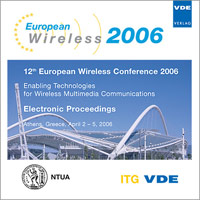Downlink Performance Improvements in (A)synchronous GPRS Networks using Single/Multiple Antenna Interference Cancellation Techniques
Conference: European Wireless 2006 - 12th European Wireless Conference 2006 - Enabling Technologies for Wireless Multimedia Communications
04/02/2006 - 04/05/2006 at Athens, Greece
Proceedings: European Wireless 2006
Pages: 7Language: englishTyp: PDF
Personal VDE Members are entitled to a 10% discount on this title
Authors:
Popova, Larissa; Gerstacker, Wolfgang H.; Koch, Wolfgang (Lehrstuhl für Mobilkommunikation, Universität Erlangen-Nürnberg, Cauerstrasse 7/NT, D-91058 Erlangen, Germany)
Meyer, Raimund; Gerstacker, Wolfgang H. (Com-Research GmbH, Wiesengrundstrasse 4, D-90765 Fürth, Germany)
Abstract:
The aim of this paper is to assess GPRS data throughput of GSM networks for single and multiple antenna interference cancellation (SAIC/MAIC) receivers in the terminals. This is done by using a two-step top-down simulation methodology. Both synchronous and asynchronous networks with traditional European reuses of 1/3 and 3/9 are considered. It turns out that SAIC/MAIC receivers are very beneficial also for European network planning. The results indicate a substantial gain in data throughput in the order of 20-35% for SAIC compared to terminals with a conventional receiver. A further dramatic increase in throughput up to 120% can be achieved by terminals using an MAIC receiver. In spite of the widespread view that a maximum gain will be achieved for a synchronized network, where the amount of overlap between desired signal and interference can be controlled, our results show that the performance of both network types is very similar.


